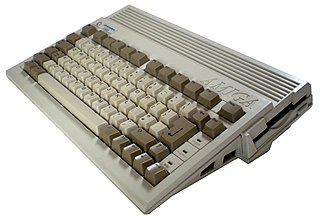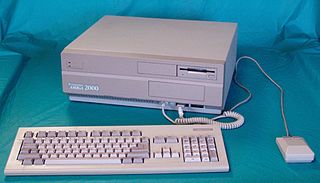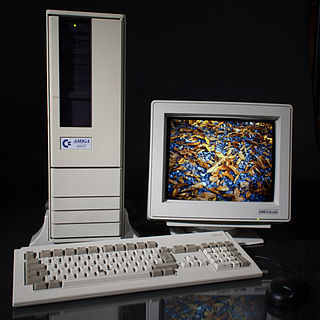
The Amiga is a family of personal computers introduced by Commodore in 1985. The original model was one of a number of 16/32- and 32-bit computers that featured 256 KB or more of RAM, mouse-based GUIs, and significantly improved graphics and audio over 8-bit systems. This wave included the Atari ST—released the same year—Apple's Macintosh, and later the Apple IIGS. Based on the Motorola 68000 microprocessor, the Amiga differed from its contemporaries through the inclusion of custom hardware to accelerate graphics and sound, including sprites and a blitter, and a pre-emptive multitasking operating system called AmigaOS.

The Amiga 500, also known as the A500, is the first low-end Commodore Amiga 16/32-bit multimedia home/personal computer. It was announced at the winter Consumer Electronics Show in January 1987 – at the same time as the high-end Amiga 2000 – and competed directly against the Atari 520ST. Before it shipped Commodore suggested a list price of US$595.95 without a monitor. At delivery in October 1987 Commodore announced that the machine would carry a US$699/£499 list price.

The Commodore Amiga 1000, also known as the A1000 and originally marketed as the Amiga, is the first personal computer released by Commodore International in the Amiga line. It combines the 16/32-bit Motorola 68000 CPU which was powerful by 1985 standards with one of the most advanced graphics and sound systems in its class, and runs a preemptive multitasking operating system that fits into 256 KB of read-only memory and shipped with 256 KB of RAM. The primary memory can be expanded internally with a manufacturer-supplied 256 KB module for a total of 512 KB of RAM. Using the external slot the primary memory can be expanded up to 8.5 MB.
The Enhanced Chip Set (ECS) is the second generation of the Amiga computer's chipset, offering minor improvements over the original chipset (OCS) design. ECS was introduced in 1990 with the launch of the Amiga 3000. Amigas produced from 1990 onwards featured a mix of OCS and ECS chips, such as later versions of the Amiga 500 and the Commodore CDTV. Other ECS models were the Amiga 500+ in 1991 and lastly the Amiga 600 in 1992.

The Amiga 600, also known as the A600, is a home computer that was introduced at the CeBIT show in March 1992. The A600 is Commodore International's final model based on the Motorola 68000 CPU and the ECS chipset. It is essentially a redesign of the Amiga 500 Plus, with the option of an internal hard disk drive and a PCMCIA port. A notable aspect of the A600 is its small size. Lacking a numeric keypad, the A600 is only slightly larger than a standard PC keyboard. It shipped with AmigaOS 2.0, which was generally considered more user-friendly than earlier versions of the operating system.

The Commodore Amiga 3000, or A3000, is a personal computer released by Commodore in June 1990. It features improved processing speed, improved graphics rendering, and a new revision of the operating system. It is the successor to the Amiga 2000.

The Amiga 2000, or A2000, is a personal computer released by Commodore in March 1987. It was introduced as a "big box" expandable variant of the Amiga 1000 but quickly redesigned to share most of its electronic components with the contemporary Amiga 500 for cost reduction. Expansion capabilities include two 3.5" drive bays and one 5.25" bay that can be used by a 5.25" floppy drive, a hard drive, or CD-ROM once they became available.
Chip RAM is a commonly used term for the integrated RAM used in Commodore's line of Amiga computers. Chip RAM is shared between the central processing unit (CPU) and the Amiga's dedicated chipset. It was also, rather misleadingly, known as "graphics RAM".

The Commodore Amiga 4000, or A4000, is the successor of the A2000 and A3000 computers. There are two models: the A4000/040 released in October 1992 with a Motorola 68040 CPU, and the A4000/030 released in April 1993 with a Motorola 68EC030.
The MOS Technology "Agnus", usually called Agnus, is an integrated circuit in the custom chipset of the Commodore Amiga computer. The Agnus, Denise and Paula chips collectively formed the OCS and ECS chipsets.
The Amiga is a family of home computers that were designed and sold by the Amiga Corporation from 1985 to 1994.
AmigaOS is the proprietary native operating system of the Amiga personal computer. Since its introduction with the launch of the Amiga 1000 in 1985, there have been four major versions and several minor revisions of the operating system.

Minimig is an open source re-implementation of an Amiga 500 using a field-programmable gate array (FPGA).

The Amiga 4000T, also known as A4000T, is a tower version of Commodore's A4000 personal computer. Using the AGA chipset, it was originally released in small quantities in 1994 with a 25 MHz Motorola 68040 CPU, and re-released in greater numbers by Escom in 1995, after Commodore's demise, along with a new variant which featured a 50 MHz Motorola 68060 CPU. Despite the subsequent demise of Escom, production was continued by QuikPak in North America into at least 1997.
Kickstart is the bootstrap firmware of the Amiga computers developed by Commodore International. Its purpose is to initialize the Amiga hardware and core components of AmigaOS and then attempt to boot from a bootable volume, such as a floppy disk. Most Amiga models were shipped with the Kickstart firmware stored on ROM chips.

AmigaOS is a family of proprietary native operating systems of the Amiga and AmigaOne personal computers. It was developed first by Commodore International and introduced with the launch of the first Amiga, the Amiga 1000, in 1985. Early versions of AmigaOS required the Motorola 68000 series of 16-bit and 32-bit microprocessors. Later versions were developed by Haage & Partner and then Hyperion Entertainment. A PowerPC microprocessor is required for the most recent release, AmigaOS 4.
The Amiga 1200, or A1200, is a personal computer in the Amiga computer family released by Commodore International, aimed at the home computer market. It was launched on October 21, 1992, at a base price of £399 in the United Kingdom and $599 in the United States.

The Amiga Walker, sometimes incorrectly known as the Mind Walker, is a prototype of an Amiga computer developed and shown by Amiga Technologies in late 1995/early 1996. Walker was planned as a replacement for the A1200 with a faster CPU, better expansion capabilities, and a built-in CD-ROM. The Walker was never released; Escom and Amiga Technologies went bankrupt, and only two prototypes were made.
In addition to the Amiga chipsets, various specially designed chips have been used in Commodore Amiga computers that do not belong to the 'Amiga chipset' in a tight sense.

The Amiga CD32 (stylized as Amiga CD32, code-named "Spellbound") is a 32-bit home video game console developed by Commodore and released in Europe, Australia, Canada and Brazil. It was first announced at the Science Museum in London on July 16, 1993, and was released in September of the same year.











